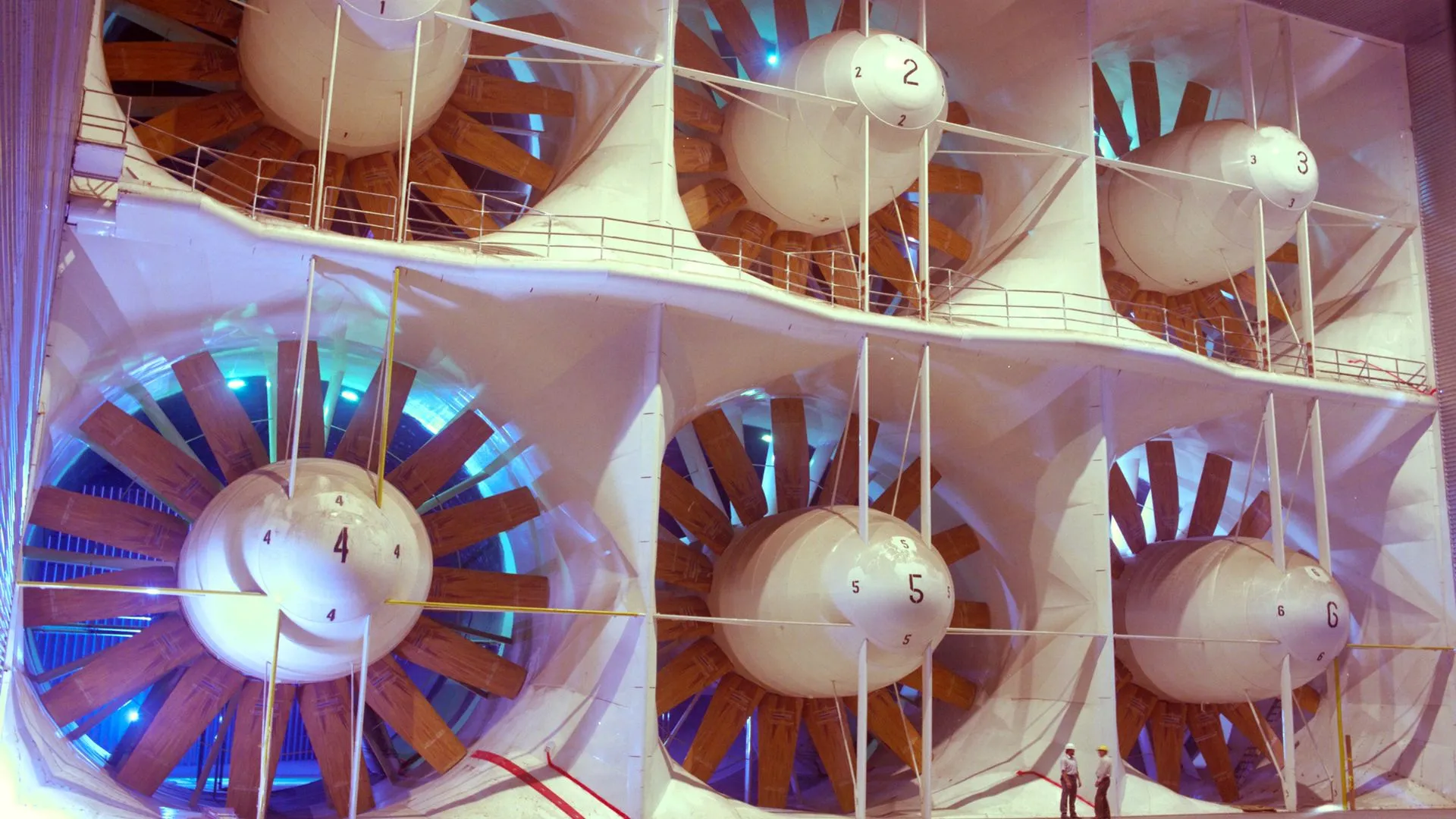Copyright Interesting Engineering

Silicon Valley is renowned as the birthplace of modern computing, home to companies like Google, Apple, and Microsoft. Yet long before venture capital and social media defined the region, an older kind of innovation was quietly taking shape at its southern edge. There, in a cluster of enormous hangars and test buildings at Moffett Field, engineers were already shaping the future, not with code and computers, but with wind. This is the NASA Ames Research Center. A place where wind became a tool of discovery. Established in 1939, Ames began as a laboratory for the National Advisory Committee for Aeronautics (NACA), the precursor to NASA. Over the decades, its researchers have studied a wide range of topics, including the aerodynamics of jet aircraft, the physics of planetary entry, and the limits of human-machine interaction. However, perhaps its most iconic contribution is its structure, which is so vast that it can hold an entire aircraft inside. The National Full-Scale Aerodynamics Complex (NFAC), home to the largest wind tunnel in the world. Veteran visual and technology journalist John Keegan, in his article on the Beautiful Public Data website, revisited the NASA Ames Research Center through a trove of archival images made public by the Internet Archive. Drawing from thousands of photographs and illustrations, he highlighted how the center’s decades of experimentation, from wind tunnels and space probes to conceptual spacecraft art, captured the evolution of American aeronautics and imagination. This article draws on some of the same archival material and insights Keegan unearthed, offering a closer look at the technological legacy of NASA Ames and its most remarkable structure. The world’s largest wind tunnel. Born of urgency: How Ames took flight In the late 1930s, the United States fell behind Europe, particularly Germany, in aeronautical research. At the time, NACA’s Langley Laboratory in Virginia had reached its capacity, and the West Coast’s rapidly expanding aviation industry demanded a counterpart. The government responded by establishing a new facility in California and selecting the site under a committee chaired by aviator Charles Lindbergh. Named after NACA founder Joseph Sweetman Ames, the lab began humbly. A few shacks, a handful of engineers, and a vision to push American aviation forward. Within a few years, it had become a major center for research in aerodynamics, aircraft design, and wind-tunnel testing, contributing to key innovations such as the swept wing and vertical takeoff aircraft. When NASA was formed in 1958, Ames transitioned seamlessly into the new space age. It expanded into fields such as astrobiology, supercomputing, and computational fluid dynamics, and became one of the first institutions to experiment with technologies that would later form the backbone of the Internet. This dual identity, deeply technical yet imaginative, remains Ames’ defining character. Inside the world’s largest wind tunnel The most recognizable structure at Ames, however, is not a computer or a laboratory. It’s the NFAC, a sprawling complex of ducts and chambers that moves enough air to simulate the flight of real aircraft at full scale. The NFAC consists of two interconnected tunnels. A closed-circuit 40×80-foot tunnel and an open-circuit 80×120-foot tunnel, the latter completed in the late 1980s and still recognized as the largest wind-tunnel test section in the world. To grasp its scale, consider this. The 80×120 test section is large enough to accommodate an entire Boeing 737, with ample room for instrumentation. The tunnels were originally conceived to enable testing that smaller facilities could never achieve. Evaluating entire aircraft, not just models, under realistic aerodynamic loads. Air in the 80×120 section can reach speeds of up to 100 knots, while the smaller 40×80 tunnel can reach speeds of up to 300 knots. Together, they provide an unparalleled range of low-speed aerodynamic testing. Unlike typical tunnels that rely on scaled-down models, the NFAC’s vast test sections allow researchers to capture real-world aerodynamic effects, including ground interactions, control-surface behavior, and engine integration. This enables the study of subtle performance nuances, particularly during takeoff and landing, which can significantly impact a design’s success. A laboratory of motion and sound What makes the NFAC extraordinary isn’t just its size. It’s the precision with which it moves air. Both tunnels share a powerful drive system that can control pressure, velocity, and turbulence levels across their massive cross-sections. This enables researchers to generate steady, uniform flows ideal for testing. In its decades of service, the NFAC has hosted a remarkable variety of experiments. It has tested the aerodynamic behavior of commercial aircraft, helicopters, rotorcraft, and even futuristic VTOL (Vertical Takeoff and Landing) concepts. Engineers have conducted tests with engines and rotors operating at full power inside the tunnel, measuring vibrations, lift, drag, and control response in real-time. The facility also serves as a center for aeroacoustics research, where scientists study the noise generated by aircraft components, from landing gear to propeller blades. The 40×80 tunnel, in particular, is equipped with acoustic liners and advanced instrumentation to measure the interaction of sound waves with aerodynamic surfaces. This research has had a direct impact on modern efforts to make commercial aircraft quieter and more environmentally friendly. Testing parachutes, rovers, and the art of landing Ames’ wind tunnels have also played an unlikely but crucial role in space exploration. The 80×120 tunnel is one of the few facilities capable of testing full-scale parachutes and decelerators for planetary missions. Before any Mars lander can descend safely onto the Red Planet, its parachutes must survive violent aerodynamic forces. Engineers at Ames inflate these enormous canopies inside the wind tunnel under simulated flight conditions, observing how the materials stretch, oscillate, and deploy. These tests have been essential to the success of missions like NASA’s Mars rovers and landers. Keegan notes that looking through the Ames archives, filled with photographs of strange, half-inflated parachutes and surreal experimental rigs, “you can feel the optimism and excitement of the time.” These images, he writes, capture the awe of seeing “strange and beautiful celestial bodies” up close for the first time. From flight to energy: The tunnel’s broader legacy Though built for aircraft, the NFAC’s applications extend far beyond aviation. Its vast chambers have been used to study the aerodynamics of wind turbines, trucks, and automobiles, helping improve efficiency and reduce drag across industries. For renewable energy, full-scale turbine blades have been mounted inside the tunnel to analyze airflow and noise patterns, research that has directly shaped modern wind energy designs. This versatility has made the NFAC valuable to both government agencies and private companies. Its unique ability to test large, complex systems under realistic conditions continues to draw industry partnerships, even in an era dominated by computer simulations. Wild experiments and the human imagination NASA Ames has long served as a playground for unconventional ideas. Within the NFAC and across its wider campus, engineers and researchers have tested radical prototypes, airships, rotorcraft, inflatables, and vertical takeoff vehicles, pushing the limits of aerodynamics and design. Beyond the tunnels, Ames fostered equally bold projects. The 1980s saw the creation of the AX-5 space suit, a hard-shelled, bubble-like prototype designed to give astronauts greater mobility and protection. Around the same time, the Human-Machine Interaction Group pioneered early work in virtual reality, building headsets and gloves that foreshadowed today’s AR/VR technology. As Keegan observes, these researchers “really saw the potential of this technology and were only limited by computing capability.” Why the NFAC still matters In the era of computational fluid dynamics (CFD) and digital twins, it may seem that physical wind tunnel testing is obsolete. But even the most advanced simulations rely on one thing. Real data. The NFAC provides that ground truth. By testing full-scale aircraft and components under controlled conditions, researchers can validate and calibrate their computational models. This union between experimental and digital remains vital to the aerospace design process. While CFD can simulate millions of data points, it struggles with complex flow separations, turbulence, and multi-body interactions. The NFAC fills that gap, ensuring that real, measurable performance data backs every aircraft certified for flight. A global benchmark in aerodynamic research Though no facility matches the NFAC in sheer size, the international race for advanced aerodynamic testing is intensifying. China’s JF-22 wind tunnel, completed around 2021, can simulate airflows up to Mach 30, placing it at the vanguard of hypersonic research. Europe’s ONERA S3MA tunnel in France reaches speeds of Mach 6, while the DNW facility in the Netherlands leads in aeroacoustics research. In contrast, the United States continues to rely on Ames’ NFAC for low-speed, full-scale testing, complemented by the Unitary Plan Wind Tunnel (UPWT) for high-speed research up to Mach 2.5. Each facility occupies its niche, representing the full spectrum of aerodynamic exploration, from takeoff to hypersonic flight. The story of NASA Ames is not only about technology; it’s about imagination. The same archives that preserve data on aircraft and spacecraft also contain vibrant concept art, imagined planets, ring-shaped habitats, and spacecraft drifting through alien skies. The tunnels at Ames are more than just tools. It is a monument to curiosity, collaboration, and the human drive to understand motion itself.



